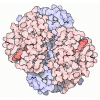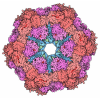Entry Database : PDB / ID : 4xxdTitle Crystal Structure of mid-region amyloid beta capture by solanezumab Amyloid-beta fragment Fab Heavy Chain Fab Light Chain Keywords / / Function / homology Function Domain/homology Component
/ / / / / / / / / / / / / / / / / / / / / / / / / / / / / / / / / / / / / / / / / / / / / / / / / / / / / / / / / / / / / / / / / / / / / / / / / / / / / / / / / / / / / / / / / / / / / / / / / / / / / / / / / / / / / / / / / / / / / / / / / / / / / / / / / / / / / / / / / / / / / / / / / / / / / / / / / / / / / / / / Biological species Homo sapiens (human)Method / / / Resolution : 2.41 Å Authors Hermans, S.J. / Crespi, G.A.N. / Parker, M.W. / Miles, L.A. Funding support Organization Grant number Country National Health and Medical Council Project Grant APP1021935
Journal : Sci Rep / Year : 2015Title : Molecular basis for mid-region amyloid-beta capture by leading Alzheimer's disease immunotherapies.Authors : Crespi, G.A. / Hermans, S.J. / Parker, M.W. / Miles, L.A. History Deposition Jan 30, 2015 Deposition site / Processing site Revision 1.0 Apr 29, 2015 Provider / Type Revision 1.1 Jul 29, 2015 Group / Structure summaryRevision 1.2 Aug 23, 2017 Group / Derived calculations / Source and taxonomyCategory diffrn_detector / diffrn_source ... diffrn_detector / diffrn_source / entity_src_gen / pdbx_entity_src_syn / pdbx_struct_oper_list Item _diffrn_detector.detector / _diffrn_source.pdbx_synchrotron_site ... _diffrn_detector.detector / _diffrn_source.pdbx_synchrotron_site / _entity_src_gen.pdbx_alt_source_flag / _pdbx_entity_src_syn.pdbx_alt_source_flag / _pdbx_struct_oper_list.symmetry_operation Revision 1.3 Sep 27, 2023 Group / Database references / Refinement descriptionCategory chem_comp_atom / chem_comp_bond ... chem_comp_atom / chem_comp_bond / database_2 / pdbx_initial_refinement_model Item / _database_2.pdbx_database_accession
Show all Show less
 Yorodumi
Yorodumi Open data
Open data Basic information
Basic information Components
Components Keywords
Keywords IMMUNE SYSTEM /
IMMUNE SYSTEM /  Fab /
Fab /  Amyloid-beta
Amyloid-beta Function and homology information
Function and homology information complement-dependent cytotoxicity / Formyl peptide receptors bind formyl peptides and many other ligands / axo-dendritic transport / synaptic assembly at neuromuscular junction / smooth endoplasmic reticulum calcium ion homeostasis / axon midline choice point recognition / astrocyte activation involved in immune response / regulation of spontaneous synaptic transmission /
complement-dependent cytotoxicity / Formyl peptide receptors bind formyl peptides and many other ligands / axo-dendritic transport / synaptic assembly at neuromuscular junction / smooth endoplasmic reticulum calcium ion homeostasis / axon midline choice point recognition / astrocyte activation involved in immune response / regulation of spontaneous synaptic transmission /  regulation of Wnt signaling pathway / mating behavior / Fc epsilon receptor (FCERI) signaling /
regulation of Wnt signaling pathway / mating behavior / Fc epsilon receptor (FCERI) signaling /  antibody-dependent cellular cytotoxicity /
antibody-dependent cellular cytotoxicity /  ciliary rootlet / Fc-gamma receptor I complex binding / Lysosome Vesicle Biogenesis /
ciliary rootlet / Fc-gamma receptor I complex binding / Lysosome Vesicle Biogenesis /  PTB domain binding / Golgi-associated vesicle / Classical antibody-mediated complement activation / positive regulation of amyloid fibril formation / neuron remodeling / Insertion of tail-anchored proteins into the endoplasmic reticulum membrane / : / Deregulated CDK5 triggers multiple neurodegenerative pathways in Alzheimer's disease models / Initial triggering of complement / presynaptic active zone / nuclear envelope lumen / modulation of excitatory postsynaptic potential / suckling behavior / COPII-coated ER to Golgi transport vesicle / immunoglobulin complex, circulating / IgG immunoglobulin complex / dendrite development / immunoglobulin receptor binding /
PTB domain binding / Golgi-associated vesicle / Classical antibody-mediated complement activation / positive regulation of amyloid fibril formation / neuron remodeling / Insertion of tail-anchored proteins into the endoplasmic reticulum membrane / : / Deregulated CDK5 triggers multiple neurodegenerative pathways in Alzheimer's disease models / Initial triggering of complement / presynaptic active zone / nuclear envelope lumen / modulation of excitatory postsynaptic potential / suckling behavior / COPII-coated ER to Golgi transport vesicle / immunoglobulin complex, circulating / IgG immunoglobulin complex / dendrite development / immunoglobulin receptor binding /  smooth endoplasmic reticulum /
smooth endoplasmic reticulum /  regulation of NMDA receptor activity / TRAF6 mediated NF-kB activation / Advanced glycosylation endproduct receptor signaling / neuromuscular process controlling balance / regulation of presynapse assembly / The NLRP3 inflammasome / immunoglobulin mediated immune response / intracellular copper ion homeostasis / transition metal ion binding / regulation of multicellular organism growth / negative regulation of long-term synaptic potentiation / FCGR activation / negative regulation of neuron differentiation / ECM proteoglycans / spindle midzone / positive regulation of T cell migration / Role of phospholipids in phagocytosis / Role of LAT2/NTAL/LAB on calcium mobilization / Scavenging of heme from plasma /
regulation of NMDA receptor activity / TRAF6 mediated NF-kB activation / Advanced glycosylation endproduct receptor signaling / neuromuscular process controlling balance / regulation of presynapse assembly / The NLRP3 inflammasome / immunoglobulin mediated immune response / intracellular copper ion homeostasis / transition metal ion binding / regulation of multicellular organism growth / negative regulation of long-term synaptic potentiation / FCGR activation / negative regulation of neuron differentiation / ECM proteoglycans / spindle midzone / positive regulation of T cell migration / Role of phospholipids in phagocytosis / Role of LAT2/NTAL/LAB on calcium mobilization / Scavenging of heme from plasma /  Purinergic signaling in leishmaniasis infection / positive regulation of calcium-mediated signaling /
Purinergic signaling in leishmaniasis infection / positive regulation of calcium-mediated signaling /  complement activation, classical pathway / forebrain development / regulation of peptidyl-tyrosine phosphorylation / positive regulation of chemokine production /
complement activation, classical pathway / forebrain development / regulation of peptidyl-tyrosine phosphorylation / positive regulation of chemokine production /  clathrin-coated pit /
clathrin-coated pit /  Notch signaling pathway /
Notch signaling pathway /  antigen binding / positive regulation of G2/M transition of mitotic cell cycle / ionotropic glutamate receptor signaling pathway / positive regulation of protein metabolic process / neuron projection maintenance / cholesterol metabolic process / extracellular matrix organization / positive regulation of glycolytic process / positive regulation of mitotic cell cycle / response to interleukin-1 /
antigen binding / positive regulation of G2/M transition of mitotic cell cycle / ionotropic glutamate receptor signaling pathway / positive regulation of protein metabolic process / neuron projection maintenance / cholesterol metabolic process / extracellular matrix organization / positive regulation of glycolytic process / positive regulation of mitotic cell cycle / response to interleukin-1 /  axonogenesis / adult locomotory behavior / FCERI mediated Ca+2 mobilization / FCGR3A-mediated IL10 synthesis / trans-Golgi network membrane / dendritic shaft / locomotory behavior / platelet alpha granule lumen / positive regulation of peptidyl-threonine phosphorylation / Antigen activates B Cell Receptor (BCR) leading to generation of second messengers /
axonogenesis / adult locomotory behavior / FCERI mediated Ca+2 mobilization / FCGR3A-mediated IL10 synthesis / trans-Golgi network membrane / dendritic shaft / locomotory behavior / platelet alpha granule lumen / positive regulation of peptidyl-threonine phosphorylation / Antigen activates B Cell Receptor (BCR) leading to generation of second messengers /  learning /
learning /  central nervous system development / positive regulation of interleukin-1 beta production / positive regulation of long-term synaptic potentiation /
central nervous system development / positive regulation of interleukin-1 beta production / positive regulation of long-term synaptic potentiation /  Regulation of Complement cascade / astrocyte activation / endosome lumen / Cell surface interactions at the vascular wall
Regulation of Complement cascade / astrocyte activation / endosome lumen / Cell surface interactions at the vascular wall
 Homo sapiens (human)
Homo sapiens (human) X-RAY DIFFRACTION /
X-RAY DIFFRACTION /  SYNCHROTRON /
SYNCHROTRON /  MOLECULAR REPLACEMENT / Resolution: 2.41 Å
MOLECULAR REPLACEMENT / Resolution: 2.41 Å  Authors
Authors Australia, 1items
Australia, 1items  Citation
Citation Journal: Sci Rep / Year: 2015
Journal: Sci Rep / Year: 2015 Structure visualization
Structure visualization Molmil
Molmil Jmol/JSmol
Jmol/JSmol Downloads & links
Downloads & links Download
Download 4xxd.cif.gz
4xxd.cif.gz PDBx/mmCIF format
PDBx/mmCIF format pdb4xxd.ent.gz
pdb4xxd.ent.gz PDB format
PDB format 4xxd.json.gz
4xxd.json.gz PDBx/mmJSON format
PDBx/mmJSON format Other downloads
Other downloads https://data.pdbj.org/pub/pdb/validation_reports/xx/4xxd
https://data.pdbj.org/pub/pdb/validation_reports/xx/4xxd ftp://data.pdbj.org/pub/pdb/validation_reports/xx/4xxd
ftp://data.pdbj.org/pub/pdb/validation_reports/xx/4xxd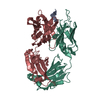
 Links
Links Assembly
Assembly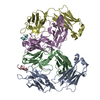


 Components
Components Fragment antigen-binding
Fragment antigen-binding
 Homo sapiens (human) / Plasmid: pcDNA3.1+ / Cell line (production host): 292-F / Production host:
Homo sapiens (human) / Plasmid: pcDNA3.1+ / Cell line (production host): 292-F / Production host: 
 Homo sapiens (human) / References: UniProt: P01834*PLUS
Homo sapiens (human) / References: UniProt: P01834*PLUS Fragment antigen-binding
Fragment antigen-binding
 Homo sapiens (human) / Plasmid: pcDNA3.1+ / Cell line (production host): 293-F / Production host:
Homo sapiens (human) / Plasmid: pcDNA3.1+ / Cell line (production host): 293-F / Production host: 
 Homo sapiens (human) / References: UniProt: P01857*PLUS
Homo sapiens (human) / References: UniProt: P01857*PLUS
 Homo sapiens (human) / References: UniProt: P05067
Homo sapiens (human) / References: UniProt: P05067 Water
Water X-RAY DIFFRACTION
X-RAY DIFFRACTION Sample preparation
Sample preparation
 SYNCHROTRON / Site:
SYNCHROTRON / Site:  Australian Synchrotron
Australian Synchrotron  / Beamline: MX2 / Wavelength: 0.9537 Å
/ Beamline: MX2 / Wavelength: 0.9537 Å : 0.9537 Å / Relative weight: 1
: 0.9537 Å / Relative weight: 1  Processing
Processing :
:  MOLECULAR REPLACEMENT
MOLECULAR REPLACEMENT Movie
Movie Controller
Controller


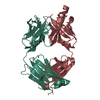




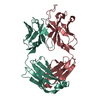



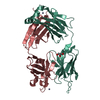

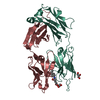
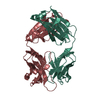

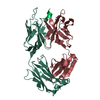
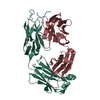
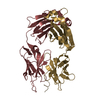
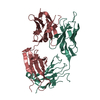
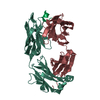

 PDBj
PDBj









